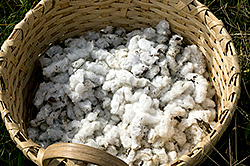Page content
Historic Farming
Cotton
Cotton was among the earliest plants to be cultivated by English settlers at Jamestown in their experimental attempts to discover valuable export crops. In 1622 a promising crop was reported in Newport News, and as late as 1692 Governor Edmund Andros was encouraging its commercial development.
Despite a reported export of 43,350 pounds sent to Great Britain in 1768, cotton never became a major crop in Virginia during its colonial period — mainly for three reasons. First is the nature of cotton itself, which likes a long and hot summer of 77 degrees mean temperature and 200 days between frosts. Virginia does not always have such favorable-to-cotton conditions.
Secondly and more importantly was the nature of the green-seeded, heavy-yielding variety whose short, course fibers adhere to its seed tightly, making the process of deseeding by hand slow and tedious. It would not be until 1793 that a breakthrough in ginning technology (Eli Whitney’s saw-type engine) would allow efficient cleaning of this variety, thus ushering in King Cotton — and a great appetitefor slave labor — into the South.
When the black, smooth, seeded variety was grown, a simple roller press could be used to quickly accomplish this critical task. Fine, long staple barbadense only grew well along the southeastern seaboard but produced less fiber than green-seeded. Oddly, both varieties seem to have been grown in Virginia with accompanying roller gins before the Revolution.
And finally, the nature of the market slowed the cultivation of large-scale cotton. Although England controlled the cotton textile industry, it was not until 1784 that innovations in manufacturing machinery stimulated demand for raw cotton beyond the traditional French, West Indian, and Brazilian sources.
Thus, during Virginia’s colonial period and following the War, cotton was generally a patch crop (less than 10 acres) grown for domestic processing and use, except during periods of high prices. Like tobacco, it was labor-intensive and required well-cultivated, rich soil. It too was grown in broadly spaced (four to eight feet) hills, but was planted like Indian corn, thinned, and sometimes placed on ridges. It required tobacco-like topping and suckering which prevented barren bushy plants. And like tobacco, it was planted in May and did not mature all at once.
However, its harvest time was later and longer, often through the months of October and November as the mature bolls dried and split open. Fluffy white wads were plucked from prickly shells and carried in linen bags at the rate of 50 to 100 pounds per day, per worker. Northern Neck planter Landon Carter reported on Oct. 20, 1770, that: “Yesterday the two wenches that went to pick the fork cotton brought home about 40 pounds in the seed.” He was probably dissatisfied with that amount. Forty pounds “in the seeds” would yield 10 pounds of clean, picked cotton worth about one shilling per pound. Thomas Jefferson estimated that 1,000 hills would yield 10 to 15 pounds of the “Common kind.”
During the early decades of the 19th century, large-scale cotton production occurred south of the James River, displacing both tobacco and Indian corn as money-makers. This resurgence of interest in growing commercial cotton peaked in 1826 with the export of 25 million pounds. Today, cotton is grown both south and north of the James River, with a commercial gin in Portsmouth.
